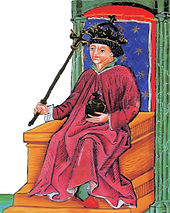Güssing feud
The armed conflicts between the Habsburg duchy of Austria and Styria and the Hungarian lords of Güns in the German-West Hungarian border area in 1289 are referred to as the Güssing feud . There were fighting in a total of 37 villages during the year. The Austrian troops remained victorious and destroyed numerous villages in the course of the fighting, which are now mainly in the Austrian Burgenland . However, the conquered rulers had to be returned to the Güns lords after the peace treaty of Hainburg (1291).
prehistory
The Lords of Güns had created a position of power in western Hungary that was too threatening for the Hungarian King Ladislaus IV . In January and February 1284, Ladislaus besieged Bernstein Castle , which was owned by Günser , but had to end the siege unsuccessfully.
The Hungarian king then asked Duke Albrecht I of Habsburg for support in the fight against the Günser. Albrecht reacted evasively at first. Ivan ( Johann I. von Güns ) thought this was a weakness of the Habsburgs, invaded Austrian territory near Wiener Neustadt and disregarded an offer of peace by the Austrian duke. Now Albrecht was forced to act and sent troops under Hermann von Landenberg to the castle in Bernstein. In the battle that followed, Ivan inflicted a crushing defeat on the Austrian army and took numerous prisoners. Ivan forced a contract on the duke in which Albrecht was obliged to assist the Günsern (except against the Hungarian king). Albrecht accepted this contract in order to at least reduce the ransom demands for the prisoners.
But already in 1287 there was fighting again between the Austrians and the Lords of Güns. In 1289, according to the Styrian rhyme chronicle of Ottokar from the Gaal , Albrecht raised an army of 15,000 men to finally overthrow the Günser.
course
In addition to fighters from Austria and Styria, Albrecht's army also included people from the bishops of Passau , Freising , Bamberg and Seckau . Albrecht carried heavy siege equipment . Opposite him stood Ivan von Güns together with his brothers Heinrich, Nikolaus and Peter (Bishop of Veszprém ) and their followers. Albrecht's campaign, often referred to as a punitive expedition, was directed not only against the Günser, but also against their allies such as the Mattersdorf-Forchtenstein counts.
Duke Albrecht crossed the Leitha near Wiener Neustadt and moved towards Mattersburg . In the course of the siege of Mattersburg, Ivan sent an offer of peace to the duke, which he refused. Mattersburg was captured by Albrecht's troops and on May 17 or 18, 1289, they moved further south to conquer the nearest fortresses. In the course of the fighting and pillage, four castles (including Eckendorf Castle ) and countless villages were completely destroyed and brought into the hands of the Duke. Bernstein Castle, to which Ivan had withdrawn, could not be captured, however.
After an interruption in the fighting in the autumn of 1289, Albrecht finally turned with his army against the headquarters of his opponents, in Güns . Ivan had the food supplies from the area brought to the castle in order to starve the besiegers and he managed to kill a hundred of the enemy’s servants. The residents of Güns had fled to the castle. Albrecht had the abandoned city set on fire. For a while, the well-fortified castle was able to withstand the besiegers. The Günser defended themselves against battering rams with fires and even deployed wild swarms of bees against the enemy. On November 1, 1289, however, the Günser were defeated.
After Albrecht's victory

In 1290 Andreas III. Successor to Ladislaus as the Hungarian king. Ivan supported Andreas and therefore had the backing of the Hungarian king again. Andreas invaded Austria and entered into negotiations with Duke Albrecht. On August 26, 1291, the peace treaty of Hainburg was concluded , finally ending the Güssing feud. Two days later, on August 28, 1291 in Pressburg , peace was made between Albrecht and the Kingdom of Hungary. The peace agreements included, among other things, the return of the conquered rulers to the Günser, the recognition of the borders before the occupation and Duke Albrecht's renunciation of the Hungarian royal crown. Furthermore, in the Hainburg Peace, the destruction of the castles involved in the feud was agreed, but this was only partially implemented.
See also
literature
- Gerald Gänser: The Güssinger feud , in "Die Güssinger" results of the symposia in the context of the "Schlaininger Talks" 1986/1987, p. 197 ff, published by Burgenländisches Landesmuseum Eisenstadt, Eisenstadt 1989
- August Ernst: History of Burgenland , R. Oldenbourg Verlag Munich, 1991, ISBN 978-3-486-54072-7
- Milletich, Forster: Contributions to a literary history of Burgenland , Ed. Sabine Milletich, Böhlau Verlag, Vienna-Cologne-Weimar 2009, ISBN 978-3-205-78308-4
credentials
- ^ "The Güssinger" results of the symposia in the context of the "Schlaininger Talks" 1986/1987, p. 342, publisher Burgenländisches Landesmuseum Eisenstadt, Eisenstadt 1989
- ↑ German Chronicles and other history books of the Middle Ages 5.1: Ottokars Austrian Reimchronik. Part 1. Edited by Joseph Seemüller based on the copies of Franz Lichtenstein . Hannover 1890, p. 350 ( Monumenta Germaniae Historica , digitized version )
